art
-
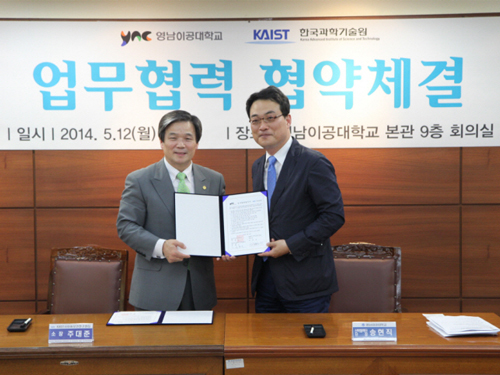 Cyber Security MOU between KAIST and Yeungnam University College (YNC)
The KAIST Cyber Security Research Center and the Department of Cyber Security at Yeungnam University College (YNC) signed a memorandum of understating (MOU) on May 12, 2014 at the YNC campus to cooperate in cyber security education and technological development.
In the MOU, KAIST and YNC agreed to collaborate for the training of professional personnel and the development of new technology for the strengthening of national cyber security, as well as the common use of mutual research environments and group participation of core tasks.
As a result of the MOU interaction, the KAIST Cyber Security Research Center and the Department of Cyber Security at YNC will pursue mutual development through the joint management of the latest educational training programs for cyber security and information protection and the development of up-to-date security technology suited for nuclear energy infrastructures and regional electronic industry complexes. They will also hold joint research seminars and forums.
The Director of the Cyber Security Research Center, Professor Dae-Joon Joo (KAIST Graduate School of Information Security) commented, “With a great deal of experience in the field of cyber security, KAIST, and its excellence in education and research areas, will contribute in many ways, such as increasing the supply of expert cyber-security personnel in the Daegu-Kyungbuk region and actively participate toward greater national cyber security through this collaboration agreement.”
[Picture]
Dae-Jun Joo, KAIST Cyber Security Research Center Director (Left) and Hyun-Jig Song (Right), Chief of Industry-Academic Cooperation Foundation at Yeungnam University College, pose after signing the cooperation agreement on cyber security.
2014.05.17 View 9912
Cyber Security MOU between KAIST and Yeungnam University College (YNC)
The KAIST Cyber Security Research Center and the Department of Cyber Security at Yeungnam University College (YNC) signed a memorandum of understating (MOU) on May 12, 2014 at the YNC campus to cooperate in cyber security education and technological development.
In the MOU, KAIST and YNC agreed to collaborate for the training of professional personnel and the development of new technology for the strengthening of national cyber security, as well as the common use of mutual research environments and group participation of core tasks.
As a result of the MOU interaction, the KAIST Cyber Security Research Center and the Department of Cyber Security at YNC will pursue mutual development through the joint management of the latest educational training programs for cyber security and information protection and the development of up-to-date security technology suited for nuclear energy infrastructures and regional electronic industry complexes. They will also hold joint research seminars and forums.
The Director of the Cyber Security Research Center, Professor Dae-Joon Joo (KAIST Graduate School of Information Security) commented, “With a great deal of experience in the field of cyber security, KAIST, and its excellence in education and research areas, will contribute in many ways, such as increasing the supply of expert cyber-security personnel in the Daegu-Kyungbuk region and actively participate toward greater national cyber security through this collaboration agreement.”
[Picture]
Dae-Jun Joo, KAIST Cyber Security Research Center Director (Left) and Hyun-Jig Song (Right), Chief of Industry-Academic Cooperation Foundation at Yeungnam University College, pose after signing the cooperation agreement on cyber security.
2014.05.17 View 9912 -
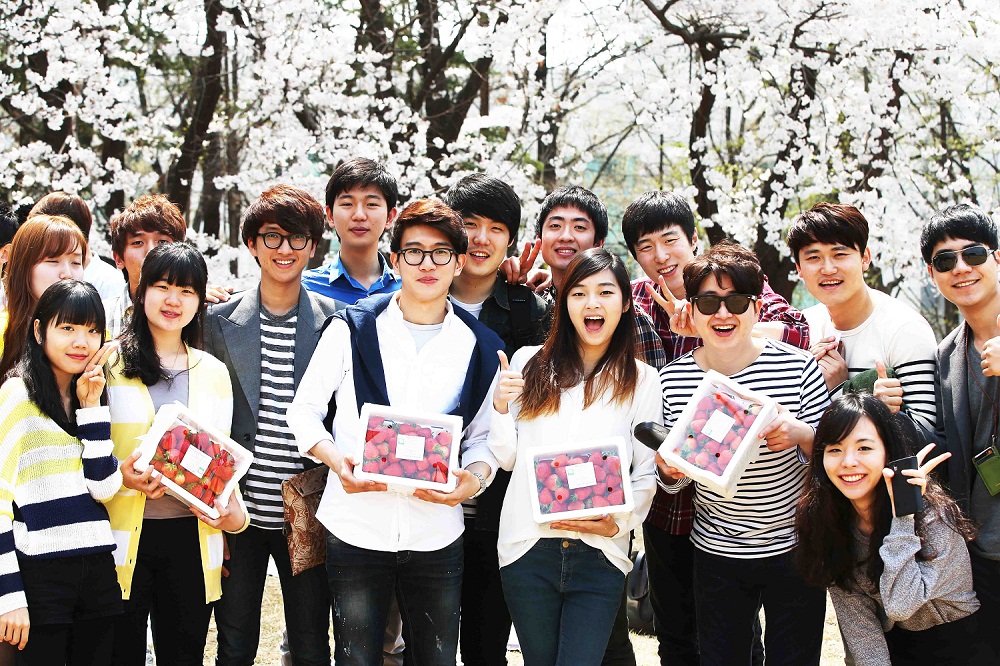 Strawberries Delivered by A Miniature Drone at KAIST Spring Festival
The "HAPPY KAIST 2014 Spring Festival" held at KAIST from 4th April
The Cherry Blossoms Festival under the theme of "Cherry Blossoms: Light and Fantasy" held on 4th April
The Strawberry Party with strawberries exclusively delivered by a miniature drone on 11th April
KAIST is holding a spring festival from April 4th through 11th.
As a part of the "HAPPY KAIST 2014" event, cherry blossoms festival and strawberry party will be held at KAIST campus starting on April 4th.
This event has been organized with the purpose of creating a new culture and tradition for members of KAIST to unite. Faculty members, staff, and students have all contributed to making the festival a success.
The cherry blossoms festival, held under the theme of "Cherry Blossoms: Light and Fantasy," takes place at the road in front of the KAIST north dormitory, which provides a spectacular view of cherry blossom trees. It begins on the night of April 4th and continues until the 8th of April.
Around the cherry blossom tree road displays an art exhibition by the Design Rangers, a student club of graduate and doctorate students from the Department of Industrial Design at KAIST. The exhibition includes the "Fantasy Cherry Blossoms" and "Let’s Walk Together."
Following on the 11th will be the "Strawberry Party" to take place throughout the campus. The strawberry party began in 1995 in order to help the local strawberry farmers. Now, it has become KAIST’s own unique tradition attended by faculty, student clubs, and laboratory members.
This year, the fruit party becomes a unique event in that there will be a demonstration of strawberry delivery by an unmanned vehicle or an unmanned aerial vehicle (a miniature drone).
When a customer orders strawberries via a smart phone application, the user's current location is sent to the central system of an unmanned vehicle. Either the unmanned vehicle (UV) transports strawberries or for places
inaccessible
by the UV such as on a lawn, the drone delivers the fruit to the customer
.
This demonstration has been organized by Professor Hyunchul Shim from the Department of Aerospace Engineering at KAIST. Professor Shim said, “If the unmanned logistics system, such as the one being demonstrated at the Strawberry Party, is commercialized, both cost and time
in the logistics industry
can be significantly reduced.”
The HAPPY KAIST 2014,
organized
by the College of Engineering, is an annual event, consisting of a total of five programs, with the purpose to make the campus happier and
healthier.
2014.04.07 View 10173
Strawberries Delivered by A Miniature Drone at KAIST Spring Festival
The "HAPPY KAIST 2014 Spring Festival" held at KAIST from 4th April
The Cherry Blossoms Festival under the theme of "Cherry Blossoms: Light and Fantasy" held on 4th April
The Strawberry Party with strawberries exclusively delivered by a miniature drone on 11th April
KAIST is holding a spring festival from April 4th through 11th.
As a part of the "HAPPY KAIST 2014" event, cherry blossoms festival and strawberry party will be held at KAIST campus starting on April 4th.
This event has been organized with the purpose of creating a new culture and tradition for members of KAIST to unite. Faculty members, staff, and students have all contributed to making the festival a success.
The cherry blossoms festival, held under the theme of "Cherry Blossoms: Light and Fantasy," takes place at the road in front of the KAIST north dormitory, which provides a spectacular view of cherry blossom trees. It begins on the night of April 4th and continues until the 8th of April.
Around the cherry blossom tree road displays an art exhibition by the Design Rangers, a student club of graduate and doctorate students from the Department of Industrial Design at KAIST. The exhibition includes the "Fantasy Cherry Blossoms" and "Let’s Walk Together."
Following on the 11th will be the "Strawberry Party" to take place throughout the campus. The strawberry party began in 1995 in order to help the local strawberry farmers. Now, it has become KAIST’s own unique tradition attended by faculty, student clubs, and laboratory members.
This year, the fruit party becomes a unique event in that there will be a demonstration of strawberry delivery by an unmanned vehicle or an unmanned aerial vehicle (a miniature drone).
When a customer orders strawberries via a smart phone application, the user's current location is sent to the central system of an unmanned vehicle. Either the unmanned vehicle (UV) transports strawberries or for places
inaccessible
by the UV such as on a lawn, the drone delivers the fruit to the customer
.
This demonstration has been organized by Professor Hyunchul Shim from the Department of Aerospace Engineering at KAIST. Professor Shim said, “If the unmanned logistics system, such as the one being demonstrated at the Strawberry Party, is commercialized, both cost and time
in the logistics industry
can be significantly reduced.”
The HAPPY KAIST 2014,
organized
by the College of Engineering, is an annual event, consisting of a total of five programs, with the purpose to make the campus happier and
healthier.
2014.04.07 View 10173 -
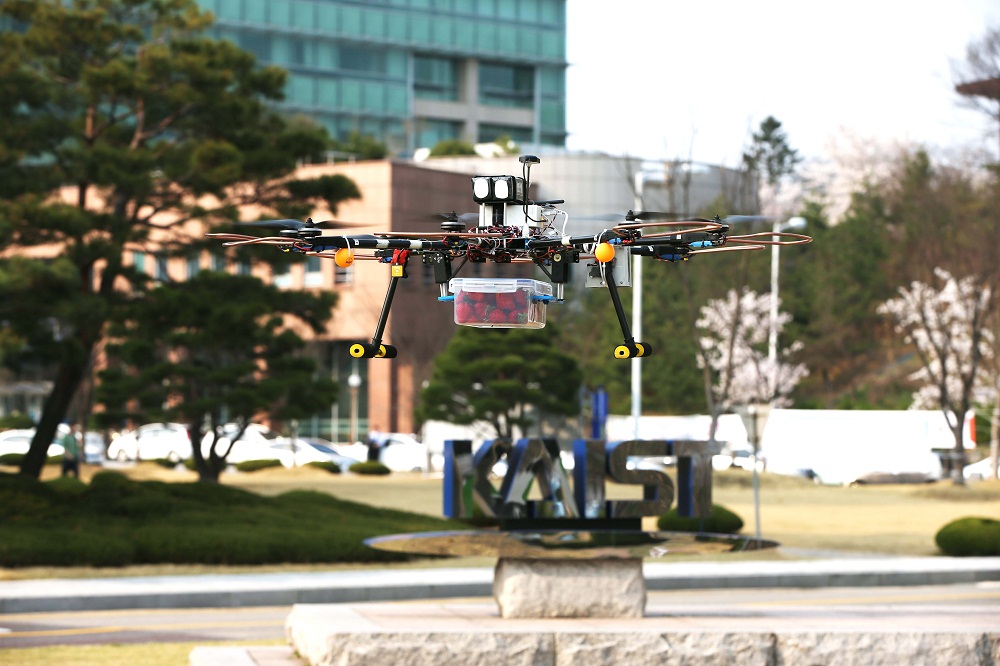 When Technology Meets Spring: A Drone Delivering Strawberries Greets the Change of Seasons in KAIST
KAIST celebrates the arrival of spring by hosting a variety of cultural events for university members as well as the surrounding community members.
The "Happy KAIST 2014" will be held from April 4 to April 11th, which includes the “Cherry Blossoms Festival” and “Strawberry Party.” The event is free and open to the public.
As part of the strawberry party, visitors to the campus can order the fruit to be delivered to the place where they sit via a drone developed by Professor Hyunchul Shim of Aerospace Engineering at KAIST.
The strawberry delivery by a drone starts on April 11. Throughout the campus, the drone will deliver up to 100 containers of strawberries to customers.
Pictures:
A drone delivers a small container of strawberries ordered by students.
2014.04.04 View 8816
When Technology Meets Spring: A Drone Delivering Strawberries Greets the Change of Seasons in KAIST
KAIST celebrates the arrival of spring by hosting a variety of cultural events for university members as well as the surrounding community members.
The "Happy KAIST 2014" will be held from April 4 to April 11th, which includes the “Cherry Blossoms Festival” and “Strawberry Party.” The event is free and open to the public.
As part of the strawberry party, visitors to the campus can order the fruit to be delivered to the place where they sit via a drone developed by Professor Hyunchul Shim of Aerospace Engineering at KAIST.
The strawberry delivery by a drone starts on April 11. Throughout the campus, the drone will deliver up to 100 containers of strawberries to customers.
Pictures:
A drone delivers a small container of strawberries ordered by students.
2014.04.04 View 8816 -
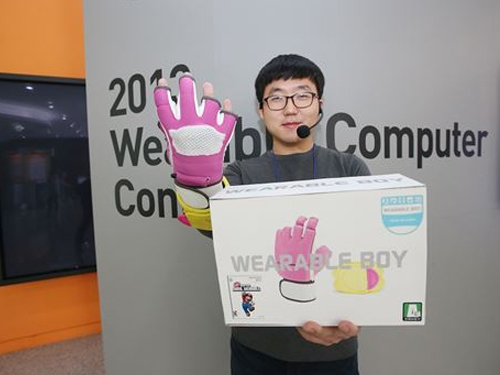 KAIST Holds 'Wearable Computer Contest'
Application for ‘2014 Wearable Computer Contest’ until May 23rd
KAIST is holding the 2014 Wearable Computer Contest (WCC) sponsored by Samsung Electronics in November and is currently receiving applications until May 23rd.
Wearable Computer is a device that can be worn on body or clothing, which allows users to be connected while on the move. It is currently receiving attention as the next generation of computer industry that will replace smart phones.
The Wearable Computer Contest will be held under the topic “Smart Fashion to Simple Life” and will be divided into a designated topic contest and an idea contest.
In the “designated topic contest,” each group will compete with their prototypes based on their own ideas about a wearable computer that combines IT and fashion. A total of 15 teams that enter the finals after a document review will be provided with USD 1,400 for a prototype production, Samsung's smart IT devices, and a systematic training program.
For the “idea contest,” competitors will present their ideas for a wearable computer in a poster format. The teams qualified to continue onto the finals will be given an opportunity to create and exhibit a life-sized model.
Chairman of the Wearable Computer Contest (WCC), Professor Hoejun Yoo from the KAIST Department of Electrical Engineering said, “Wearable Computer is the major future growth industry that will lead IT industry after smart phones. I hope WCC will help nurture the future professionals in the field of wearable computer industry.”
The applications for the Wearable Computer Contest can be found on the main website (http://www.ufcom.org) until May 23rd. Both undergraduate and graduate students can participate as a team for the “designated topic contest,” and there are no qualifications required for those who enter the “idea contest.”
Last year, a total of 104 teams from universities all around Korea has participated in the Wearable Computer Contest. The finalist, team 'Jump' from Chungnam University, received the Award of the Minister of Science, ICT and Future Planning, Republic of Korea.
2014.03.28 View 11166
KAIST Holds 'Wearable Computer Contest'
Application for ‘2014 Wearable Computer Contest’ until May 23rd
KAIST is holding the 2014 Wearable Computer Contest (WCC) sponsored by Samsung Electronics in November and is currently receiving applications until May 23rd.
Wearable Computer is a device that can be worn on body or clothing, which allows users to be connected while on the move. It is currently receiving attention as the next generation of computer industry that will replace smart phones.
The Wearable Computer Contest will be held under the topic “Smart Fashion to Simple Life” and will be divided into a designated topic contest and an idea contest.
In the “designated topic contest,” each group will compete with their prototypes based on their own ideas about a wearable computer that combines IT and fashion. A total of 15 teams that enter the finals after a document review will be provided with USD 1,400 for a prototype production, Samsung's smart IT devices, and a systematic training program.
For the “idea contest,” competitors will present their ideas for a wearable computer in a poster format. The teams qualified to continue onto the finals will be given an opportunity to create and exhibit a life-sized model.
Chairman of the Wearable Computer Contest (WCC), Professor Hoejun Yoo from the KAIST Department of Electrical Engineering said, “Wearable Computer is the major future growth industry that will lead IT industry after smart phones. I hope WCC will help nurture the future professionals in the field of wearable computer industry.”
The applications for the Wearable Computer Contest can be found on the main website (http://www.ufcom.org) until May 23rd. Both undergraduate and graduate students can participate as a team for the “designated topic contest,” and there are no qualifications required for those who enter the “idea contest.”
Last year, a total of 104 teams from universities all around Korea has participated in the Wearable Computer Contest. The finalist, team 'Jump' from Chungnam University, received the Award of the Minister of Science, ICT and Future Planning, Republic of Korea.
2014.03.28 View 11166 -
 ACM Interactions: Demo Hour, March and April 2014 Issue
The
Association for Computing Machinery (ACM), the largest educational and scientific
computing society in the world, publishes a magazine called
Interactions
bi-monthly.
Interactions
is the flagship magazine
for the ACM’s Special Interest Group on Computer-Human Interaction (SIGCHI) with
a global circulation that includes all SIGCHI members.
In
its March and April 2014 issue, the Smart E-book was introduced. It was developed by Sangtae Kim, Jaejeung
Kim, and Soobin Lee at the Information Technology Convergence in KAIST
Institute, KAIST.
For
the article, please go to the link or download the .pdf files below:
Interactions,
March &
April 2014
Demo Hour: Bezel-Flipper
Bezel-Flipper
Interactions_Mar & Apr 2014.pdf
http://interactions.acm.org/archive/view/march-april-2014/demo-hour29
2014.03.28 View 11303
ACM Interactions: Demo Hour, March and April 2014 Issue
The
Association for Computing Machinery (ACM), the largest educational and scientific
computing society in the world, publishes a magazine called
Interactions
bi-monthly.
Interactions
is the flagship magazine
for the ACM’s Special Interest Group on Computer-Human Interaction (SIGCHI) with
a global circulation that includes all SIGCHI members.
In
its March and April 2014 issue, the Smart E-book was introduced. It was developed by Sangtae Kim, Jaejeung
Kim, and Soobin Lee at the Information Technology Convergence in KAIST
Institute, KAIST.
For
the article, please go to the link or download the .pdf files below:
Interactions,
March &
April 2014
Demo Hour: Bezel-Flipper
Bezel-Flipper
Interactions_Mar & Apr 2014.pdf
http://interactions.acm.org/archive/view/march-april-2014/demo-hour29
2014.03.28 View 11303 -
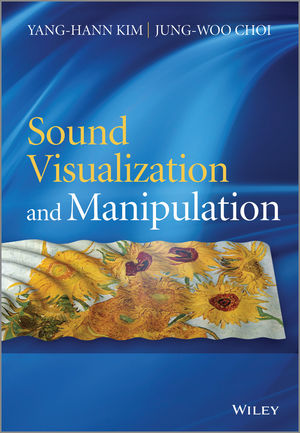 Book Announcement: Sound Visualization and Manipulation
The movie
Gravity
won seven Oscar awards this year, one of which was for its outstanding 3D sound mixing, immersing viewers in the full experience of the troubled space expedition.
3D audio effects are generated by manipulating the sound produced by speakers, speaker-arrays, or headphones to place a virtual sound source at a desired location in 3D space such as behind, above, or below the listener's head.
Two professors from the Department of Mechanical Engineering at KAIST have recently published a book that explains two important technologies related to 3D sound effects: sound visualization and manipulation.
Professor Yang-Hann Kim, an eminent scholar in sound engineering, and Professor Jung-Woo Choi collaborated to write Sound Visualization and Manipulation (Wily 2013), which uniquely addresses the two most important problems in the field in a unified way.
The book introduces general concepts and theories and describes a number of techniques in sound visualization and manipulation, offering an interrelated approach to two very different topics: sound field visualization techniques based on microphone arrays and controlled sound field generation techniques using loudspeaker arrays.
The authors also display a solid understanding of the associated physical and mathematical concepts applied to solve the visualization and manipulation problems and provide extensive examples demonstrating the benefits and drawbacks of various applications, including beamforming and acoustic holography technology.
The book will be an excellent reference for graduate students, researchers, and professionals in acoustic engineering, as well as in audio and noise control system development.
For detailed descriptions of the book:
http://as.wiley.com/WileyCDA/WileyTitle/productCd-1118368479.html
2014.03.10 View 14429
Book Announcement: Sound Visualization and Manipulation
The movie
Gravity
won seven Oscar awards this year, one of which was for its outstanding 3D sound mixing, immersing viewers in the full experience of the troubled space expedition.
3D audio effects are generated by manipulating the sound produced by speakers, speaker-arrays, or headphones to place a virtual sound source at a desired location in 3D space such as behind, above, or below the listener's head.
Two professors from the Department of Mechanical Engineering at KAIST have recently published a book that explains two important technologies related to 3D sound effects: sound visualization and manipulation.
Professor Yang-Hann Kim, an eminent scholar in sound engineering, and Professor Jung-Woo Choi collaborated to write Sound Visualization and Manipulation (Wily 2013), which uniquely addresses the two most important problems in the field in a unified way.
The book introduces general concepts and theories and describes a number of techniques in sound visualization and manipulation, offering an interrelated approach to two very different topics: sound field visualization techniques based on microphone arrays and controlled sound field generation techniques using loudspeaker arrays.
The authors also display a solid understanding of the associated physical and mathematical concepts applied to solve the visualization and manipulation problems and provide extensive examples demonstrating the benefits and drawbacks of various applications, including beamforming and acoustic holography technology.
The book will be an excellent reference for graduate students, researchers, and professionals in acoustic engineering, as well as in audio and noise control system development.
For detailed descriptions of the book:
http://as.wiley.com/WileyCDA/WileyTitle/productCd-1118368479.html
2014.03.10 View 14429 -
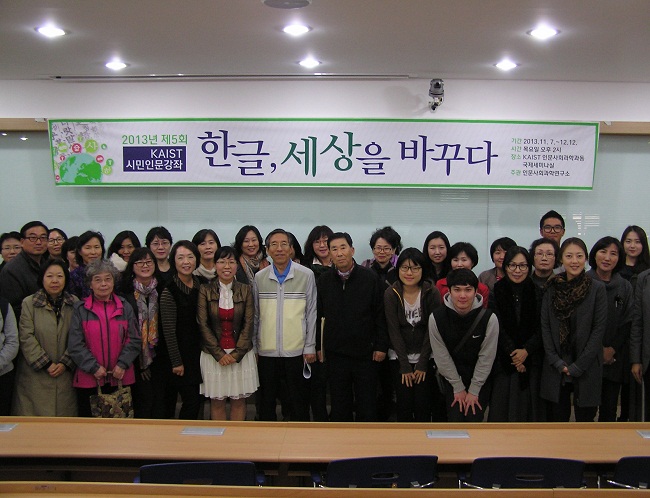 KAIST Holds Open Lecture For Daejeon Residents
Free of cost for any Korean citizen, the registration for the new course opens on the official website from 5th March KAIST’s Department of Humanities and Social Science is currently operating free humanities and liberal arts classes for Daejeon residents.
The theme of the course for this semester is “World and Politics,” which will begin on 13th March and run every Thursday for 6 weeks at KAIST’s International Seminar Room.
This course has been organized to introduce the general public to the current political situation with neighboring countries such as China, Japan and North Korea, as well as the characteristics of multinational companies.
Top experts in the related fields will give lectures. First, Professor Ha-Yong Jung from Kyunghee University will talk on “American liberalism and democracy”; Professor Gyeong-Mo An from Korea National Defense University on “Kim Jeong-Eun and the Future of North Korea--Is the Collapse of North Korea A Reality?” and Ja-Seon Koo, a visiting professor at Korea National Diplomatic Academy on “The Chinese Communist Party during the Xi Jinping Period.”
“With the era of globalization, the political situations in the neighboring countries have both direct and indirect effects on our lives,” said Professor Hyeon-Seok Park who has organized the courses. "These classes will be an opportunity for our citizens to understand and learn about the current affairs in the world.”
Anyone can attend the course, and registration is from March 5th to 9th at the official webpage of KAIST’s Humanities and Social Sciences Department (http://hss.kaist.ac.kr). All the courses are free of charge.
Contact: Department of Humanities and Social Science Research (Tel. 350-4687, E-mail: baobab@kaist.ac.kr)
2014.03.06 View 7197
KAIST Holds Open Lecture For Daejeon Residents
Free of cost for any Korean citizen, the registration for the new course opens on the official website from 5th March KAIST’s Department of Humanities and Social Science is currently operating free humanities and liberal arts classes for Daejeon residents.
The theme of the course for this semester is “World and Politics,” which will begin on 13th March and run every Thursday for 6 weeks at KAIST’s International Seminar Room.
This course has been organized to introduce the general public to the current political situation with neighboring countries such as China, Japan and North Korea, as well as the characteristics of multinational companies.
Top experts in the related fields will give lectures. First, Professor Ha-Yong Jung from Kyunghee University will talk on “American liberalism and democracy”; Professor Gyeong-Mo An from Korea National Defense University on “Kim Jeong-Eun and the Future of North Korea--Is the Collapse of North Korea A Reality?” and Ja-Seon Koo, a visiting professor at Korea National Diplomatic Academy on “The Chinese Communist Party during the Xi Jinping Period.”
“With the era of globalization, the political situations in the neighboring countries have both direct and indirect effects on our lives,” said Professor Hyeon-Seok Park who has organized the courses. "These classes will be an opportunity for our citizens to understand and learn about the current affairs in the world.”
Anyone can attend the course, and registration is from March 5th to 9th at the official webpage of KAIST’s Humanities and Social Sciences Department (http://hss.kaist.ac.kr). All the courses are free of charge.
Contact: Department of Humanities and Social Science Research (Tel. 350-4687, E-mail: baobab@kaist.ac.kr)
2014.03.06 View 7197 -
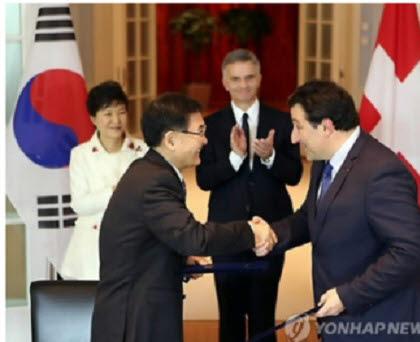 2014 Davos Forum: KAIST-EPFL Connection
The Korean-American Science and Technology News (KASTN), a biweekly global electronic newsletter carrying news and analyses in science and technology, as well as social, economic, and cultural issues related to the general interest of the Korean-American professional community, published an article on the partnership agreement made by KAIST and the Ecole Polytechnique Federale Lausanne (EPFL) during the 2014 World Economic Forum held at Davos, Switzerland, from January 22nd to 25th.
For the article, please click the link below: KASTN Issue 14-05, February 26, 2014
http://www.phy.duke.edu/~myhan/b_14-05.pdf
2014.02.04 View 9447
2014 Davos Forum: KAIST-EPFL Connection
The Korean-American Science and Technology News (KASTN), a biweekly global electronic newsletter carrying news and analyses in science and technology, as well as social, economic, and cultural issues related to the general interest of the Korean-American professional community, published an article on the partnership agreement made by KAIST and the Ecole Polytechnique Federale Lausanne (EPFL) during the 2014 World Economic Forum held at Davos, Switzerland, from January 22nd to 25th.
For the article, please click the link below: KASTN Issue 14-05, February 26, 2014
http://www.phy.duke.edu/~myhan/b_14-05.pdf
2014.02.04 View 9447 -
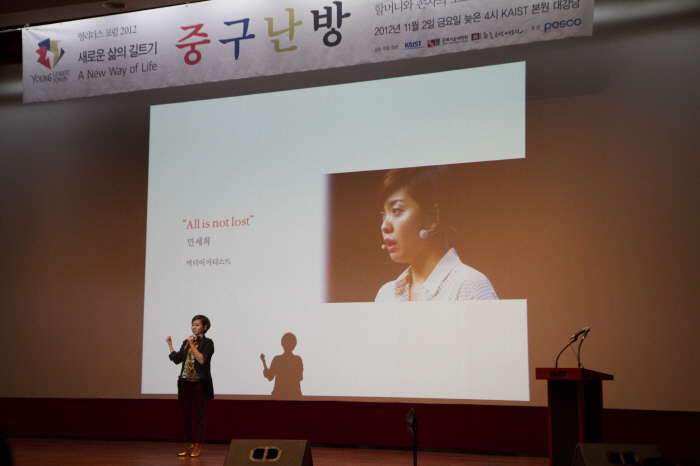 Collaborated Performance and Talk Battle Event Held by Graduate School of Culture Technology, KAIST
A unique event consisting of a new media performance and talk battle was held for middle school, high school, and college students during the winter break.
The Graduate School of Culture Technology at KAIST and the Korea Art Conservatory co-organized the 3rd Young Leaders Forum under the title “Collaboration of the Current and the New Culture” on January 18th at the Seoul Namsan Traditional Theater.
The Young Leaders Forum was founded to share knowledge and wisdom among different fields and generations and to foster creative lifestyles through the collaboration of wisdom.
The collaborated performance, “The Garden of Western Heaven”, was performed using new media technology by students from the Graduate School of Culture Technology and actors from the Korea Art Conservatory.
Three panels participated in the “Talk Battle” and held a discussion on “The New Culture from Performance and Collaboration”.
Woong-Rae Cho, CEO of The Mackiss Company, who sponsored the clay road in Gyejok Mountain and the Concert in the Forest, Professor Sung-Kuk Kim from School of Korean Music at Chung-Ang University, and Je-Ho Oh, a graduate student from the Graduate School of Culture Technology at KAIST participated in the discussion and shared their opinions with the audience.
2014.01.27 View 6674
Collaborated Performance and Talk Battle Event Held by Graduate School of Culture Technology, KAIST
A unique event consisting of a new media performance and talk battle was held for middle school, high school, and college students during the winter break.
The Graduate School of Culture Technology at KAIST and the Korea Art Conservatory co-organized the 3rd Young Leaders Forum under the title “Collaboration of the Current and the New Culture” on January 18th at the Seoul Namsan Traditional Theater.
The Young Leaders Forum was founded to share knowledge and wisdom among different fields and generations and to foster creative lifestyles through the collaboration of wisdom.
The collaborated performance, “The Garden of Western Heaven”, was performed using new media technology by students from the Graduate School of Culture Technology and actors from the Korea Art Conservatory.
Three panels participated in the “Talk Battle” and held a discussion on “The New Culture from Performance and Collaboration”.
Woong-Rae Cho, CEO of The Mackiss Company, who sponsored the clay road in Gyejok Mountain and the Concert in the Forest, Professor Sung-Kuk Kim from School of Korean Music at Chung-Ang University, and Je-Ho Oh, a graduate student from the Graduate School of Culture Technology at KAIST participated in the discussion and shared their opinions with the audience.
2014.01.27 View 6674 -
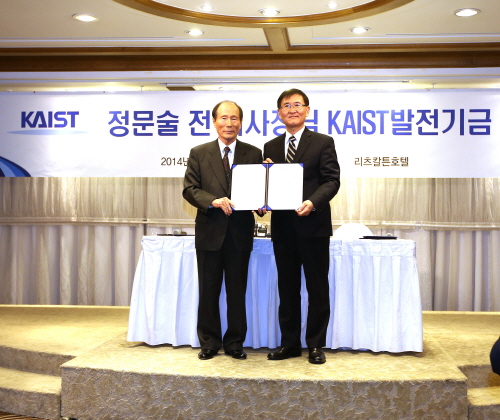 KAIST receives $20 million donation for futures studies
A retired businessman, Moon-Soul Chung, the former chief executive officer of Mirae, Inc., a semiconductor equipment company in Korea, today donated USD 20 million to the Graduate School of Future Strategy at KAIST.
It was Chung's second contribution to KAIST—his first donation of USD 28 million in 2001 supported the construction of the Bio and Brain Engineering building, a major research center on campus where biotechnology and information technology converge.
Established in 2013, the KAIST Graduate School of Future Strategy consists of three interdisciplinary graduate programs on future strategy, intellectual property, and science journalism. The Research Center for Future Strategy is an affiliate of the graduate school. KAIST is the first Korean university that offers an academic program granting a degree in futures studies.
The rapid advancement in science and technology today affects, profoundly and extensively, all corners of global society from education, politics, economy, and environment to resources, sustainability, and inequality. As we live in a highly interconnected, digitalized, and unpredictable world, analyzing the events, trends, patterns, and changes of the past and present, developing foresight, and mapping preferred futures have become more relevant than ever.
KAIST utilizes its strong tech-knowledge base in science and engineering to offer students a high quality education and training in futures thinking, skills, and methodologies to develop foresight and to plan future strategies for international relations, business and industry, national defense, science and technology, and new media. KAIST also anticipates helping government, business, public service, and non-profit organizations identify important issues and develop long-range implementation strategies to prepare for probable and preferred futures.
Moon-Soul Chung (left), the former CEO of Mirae Inc., and President Steve Kang (right), holding together the donation agreement in Seoul, January 10th, 2014
2014.01.13 View 8959
KAIST receives $20 million donation for futures studies
A retired businessman, Moon-Soul Chung, the former chief executive officer of Mirae, Inc., a semiconductor equipment company in Korea, today donated USD 20 million to the Graduate School of Future Strategy at KAIST.
It was Chung's second contribution to KAIST—his first donation of USD 28 million in 2001 supported the construction of the Bio and Brain Engineering building, a major research center on campus where biotechnology and information technology converge.
Established in 2013, the KAIST Graduate School of Future Strategy consists of three interdisciplinary graduate programs on future strategy, intellectual property, and science journalism. The Research Center for Future Strategy is an affiliate of the graduate school. KAIST is the first Korean university that offers an academic program granting a degree in futures studies.
The rapid advancement in science and technology today affects, profoundly and extensively, all corners of global society from education, politics, economy, and environment to resources, sustainability, and inequality. As we live in a highly interconnected, digitalized, and unpredictable world, analyzing the events, trends, patterns, and changes of the past and present, developing foresight, and mapping preferred futures have become more relevant than ever.
KAIST utilizes its strong tech-knowledge base in science and engineering to offer students a high quality education and training in futures thinking, skills, and methodologies to develop foresight and to plan future strategies for international relations, business and industry, national defense, science and technology, and new media. KAIST also anticipates helping government, business, public service, and non-profit organizations identify important issues and develop long-range implementation strategies to prepare for probable and preferred futures.
Moon-Soul Chung (left), the former CEO of Mirae Inc., and President Steve Kang (right), holding together the donation agreement in Seoul, January 10th, 2014
2014.01.13 View 8959 -
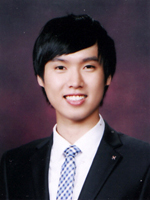 KAIST Student Awarded Prize from Energy Saving Contest
Jun-Min Kwon, an undergraduate student in the Department of Chemistry at KAIST, was awarded a prize from the Ministry of Trade, Industry and Energy, Republic of Korea, at the 35th Energy Saving Contest which was held on November 20.
The student club he has been leading was also selected as one of the best groups by the Save Energy Save Earth (SESE), a volunteer organization supported by the Korea Energy Management Corporation and the Ministry of Knowledge Economy, Republic of Korea.
Kwon began promoting energy conservation through a blog and participated in related meetings and workshops as a high school student to improve the understanding on the importance of energy saving and recycling.He also received awards from the Second National Assembly Forum on Climate Change, the Korean National Science Fair, as well as the Samsung Human Tech Paper Award.
2013.12.24 View 13531
KAIST Student Awarded Prize from Energy Saving Contest
Jun-Min Kwon, an undergraduate student in the Department of Chemistry at KAIST, was awarded a prize from the Ministry of Trade, Industry and Energy, Republic of Korea, at the 35th Energy Saving Contest which was held on November 20.
The student club he has been leading was also selected as one of the best groups by the Save Energy Save Earth (SESE), a volunteer organization supported by the Korea Energy Management Corporation and the Ministry of Knowledge Economy, Republic of Korea.
Kwon began promoting energy conservation through a blog and participated in related meetings and workshops as a high school student to improve the understanding on the importance of energy saving and recycling.He also received awards from the Second National Assembly Forum on Climate Change, the Korean National Science Fair, as well as the Samsung Human Tech Paper Award.
2013.12.24 View 13531 -
 Prime Minister's Prize for KAIST TBIC at 2013 Korean Venture & Business Expo
The KAIST Technology Business Incubation Center (TBIC) received the Prime Minister’s Prize at the 2013 Korean Venture & Business Expo. TBIC started its service in 1994 and was selected as the best center by the Asia Association of Business Incubation (AABI) in 2007.
The center has contributed to business incubation for competitive enterprises through consulting, venture capital, educational curriculums, and infrastructure service. It has also encouraged and activated business startups by KAIST students through educational programs and supporting services such as hidden champion buildup, mentoring & networking, startup auditions, and special lecture sessions for entrepreneurship.
TBIC has supported 488 businesses since 1994, and 278 companies (57%) are still in business. Eleven companies have been listed on the Korea Stock Exchange through the support of TBIC and eight of them are still on the list as of today. Those companies have been contributing to the national economy with total sales of 1.9 trillion won and in job creation by hiring 5,908 employees.
2013.12.11 View 8366
Prime Minister's Prize for KAIST TBIC at 2013 Korean Venture & Business Expo
The KAIST Technology Business Incubation Center (TBIC) received the Prime Minister’s Prize at the 2013 Korean Venture & Business Expo. TBIC started its service in 1994 and was selected as the best center by the Asia Association of Business Incubation (AABI) in 2007.
The center has contributed to business incubation for competitive enterprises through consulting, venture capital, educational curriculums, and infrastructure service. It has also encouraged and activated business startups by KAIST students through educational programs and supporting services such as hidden champion buildup, mentoring & networking, startup auditions, and special lecture sessions for entrepreneurship.
TBIC has supported 488 businesses since 1994, and 278 companies (57%) are still in business. Eleven companies have been listed on the Korea Stock Exchange through the support of TBIC and eight of them are still on the list as of today. Those companies have been contributing to the national economy with total sales of 1.9 trillion won and in job creation by hiring 5,908 employees.
2013.12.11 View 8366